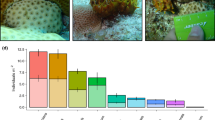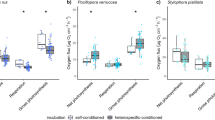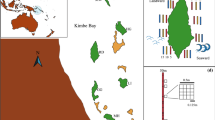Abstract
The potential role of competition for space in a community depends on the arrangement of interaction relationships. A survey (255 m2) of the interactions between corals (Scleractinia) on a Caribbean reef (depth 10–30 m) indicated the outcome of 17–35% of the aggressive and defensive interactions to be unpredictable. Experiments on the reef (depth 7–13 m) with pairs of interacting corals — Madracis mirabilis (Duchassing & Michelotti), Agaricia agaricites (L), Montastrea annularis (Ellis & Solander), Eusmilia fastigiata (Pallas) — showed that, after the initial contest through extracoelenteric digestion, there are at least two additional processes which can result in a reversal of dominance: interference by epifauna and sweeper tentacle development. Moreover, the impact of extracoelenteric digestion and the extent of sweeper tentacle development varied over the surface of the corals. Employing laboratory and field experiments to distinguish between the impact of extracoelenteric digestion, epifauna behaviour and sweeper tentacles, we show the three processes combined to explain the coral interaction process in toto. The outcome of the interaction process on the reef depends on numerous, partly unpredictable, variables, including mode of contact and effects of position. Consequently, patterns of community organization resulting from spatial competition will be slow to emerge and easily erased prematurely by disturbances.
Similar content being viewed by others
Literature Cited
Bak, R. P. M. and J. H. B. W. Elgershuizen: Patterns of oil-sediment rejection in corals. Mar. Biol. 37, 105–113 (1976)
Bak, R. P. M. and M. S. Engel: Distribution, abundance and survival of juvenile hermatypic corals (Scleractinia) and the importance of life history strategies in the parent coral community. Mar. Biol. 54, 341–352 (1979)
Bak, R. P. M. and B. E. Luckhurst: Constancy and change in coral reef habitats along depth gradients at Curaçao. Oecologia (Berl.) 47, 145–155 (1980)
Bak, R. P. M. and S. R. Criens: Survival after fragmentation of colonies of Madracis mirabilis, Acropora palmata and A. cervicornis (Scleractinia) and the subsequent impact of a coral disease. Proc. Fourth Int. Coral Reef Symp. Manilla. (In press)
Bruce, A. J.: Shrimps and prawus of coral reefs with special reference to commensalism. In: Biology and geology of coral reefs Vol. III: Biology 2, pp 37–94. Ed. by O. A. Jones and R. Endean New York: Academic Press 1976
Buss, L. W. and J. B. C. Jackson: Competitive networds: non-transitive competitive relationships in cryptic coral reef environments. Am. Nat. 113, 223–234 (1979)
Connell, J. H.: Population ecology of reef-building corls. In: Biology and geology of coral reefs Vol. II: Biology 1, pp 205–245. Ed by O. A. Jones and R. Endean. New York: Academic Press 1973
Connell, J. H.: Competitive interactions and the species diversity of corals. In: Coelenterate ecology and behaviour, pp 51–58. Ed. by G. O. Mackie, New York: Plenum Press 1976
Connell, J. H.: Diversity in tropical rain forests and coral reefs. Science, N. Y. 199, 1302–1310 (1978)
Cope, M.: Interspecific coral interactions in Hong Kong. Abstract Fourth Int. Coral reef Symp Manilla (1981)
Dekker, R. and R. P. M. Bak: Aggressive and defensive interactions in three species of stony corals (Scleractinia). Proc. Ass. Isl. Mar. Lab. Carib. 15, 5 (1980)
Glynn, P. W.: Rolling stones among the Scleractinia: mobile coralliths in the Gulf of Panamá. Proc. Second Int. Coral Reef Symp 2, 183–198 (1974)
Glynn, P. W.: Some physical and biological determinants of coral community structure in the Eastern Pacific. Ecol. Monogr. 40, 431–456 (1976)
Glynn, P. W.: Defense by symbiotic crustacea of host corals elicited by chemical cues from predator. Oecologia (Berl.) 47, 287–290 (1980)
Glynn, P. W., R. H. Steward and J. E. McCosker: Pacific coral reefs of Panamá: structure, distribution and predators. Geol. Rdsch 61, 483–519 (1972)
Glynn, P. W., G. M. Wellington and C. Birkeland: Coral reef growth in the Galapagos: Limitations by sea urchins. Science N.Y. 203, 47–49 (1979)
Grassle, J. F.: Variety in coral reef communities. In: Biology and geology of coral reefs, Vol 2, Biology 1, pp 247–270. Ed. by O. A. Jones and R. Endean. New York: Academic Press 1973
Hartog, J. C. den: The marginal tentacles of Rhodactis sanctithomae (Corallimorpharia) and the sweeper tentacles of Montastrea cavernosa (Scleractinia); their cnidom and possible function. Ed. by D. L. Taylor, Miami School of Atmospheric Sciences, University of Miami. Proc. 3rd Int. Symp. coral Reefs 1, 463–469 (1977)
Kay, A. M. and M. J. Keough: Occupation of patches in the epifaunal communities on pier pilings and the bivalve Pinna bicolor at Edithburgh, South Australia. Oecologia (Berl.) 48, 123–130 (1981)
Lang, J. C.: Interspecific aggression within the scleractinian reef corals, 177 pp. Ph.D. thesis, Yale University, New Haven, Connecticut 1970
Lang, J. C.: Interspecific aggression by scleractinian corals I. The rediscovery of Scolymia cubensis (Milne Edwards & Haime). Bull. mar. Sci. 21, 952–959 (1971)
Lang, J. C.: Interspecific aggression by scleractinian corals II. Why the race is not only to the swift. Bull. mar. Sci. 23, 260–279 (1973)
Lewis, J. B. and W. S. Price: Feeding mechanisms and feeding strategies of Atlantic reef corals. J. Zool. Lond. 176, 527–545 (1975)
Loya, Y.: The Red Sea coral Stylophora pistillata is an r strategist. Nature, Lond. 259, 478–480 (1976a)
Loya,.: The recolonization of Red Sea corals affected by natural catastrophies and man-made perturbations. Ecology 57, 278–289 (1976b)
McCloskey, L. R.: The dynamics of the community associated with a marine scleractinian coral. Int. Revue ges. Hydrobiol. Hydrogr. 55, 13–81 (1970)
Patton, W. K.: Studies on Domecia acanthophora, a commensal crab from Puerto Rico, with particular reference to modifications of the coral host and feeding habits. Biol. Bull. mar. biol. Lab., Woods Hole 132, 56–67 (1967)
Patton, W. K.: Animal associates of living reef corals. In: Biology and geology of coral reefs Vol. III, Biology 2, pp 1–37. Ed. by O. A. Jones and R. Endean 1976
Price, W. S.: Aspects of feeding behaviour of West Indian reef corals. M. Sc. thesis McGill University, Montreal, Canada, 123 pp. 1973
Richardson, C. A., P. Dustan and J. C. Lang: Maintenance of living space by sweeper tentacles of Montastrea cavernosa, a Caribbean reef coral. Mar. Biol. 55, 181–186 (1979)
Sheppard, C. R. C. Interspecific aggression between reef corals with reference to their distribution. Mar. Ecol. Prog. Ser. 1, 237–247 (1979)
Wellington, G. M.: Reversal of digestive interactions between Pacific reef corals: mediation by sweeper tentacles. Oecologia (Berl.) 47, 340–343 (1980)
Author information
Authors and Affiliations
Additional information
Communicated by O. Kinne, Hamburg
Rights and permissions
About this article
Cite this article
Bak, R.P.M., Termaat, R.M. & Dekker, R. Complexity of coral interactions: Influence of time, location of interaction and epifauna. Mar. Biol. 69, 215–222 (1982). https://doi.org/10.1007/BF00396901
Accepted:
Issue Date:
DOI: https://doi.org/10.1007/BF00396901




